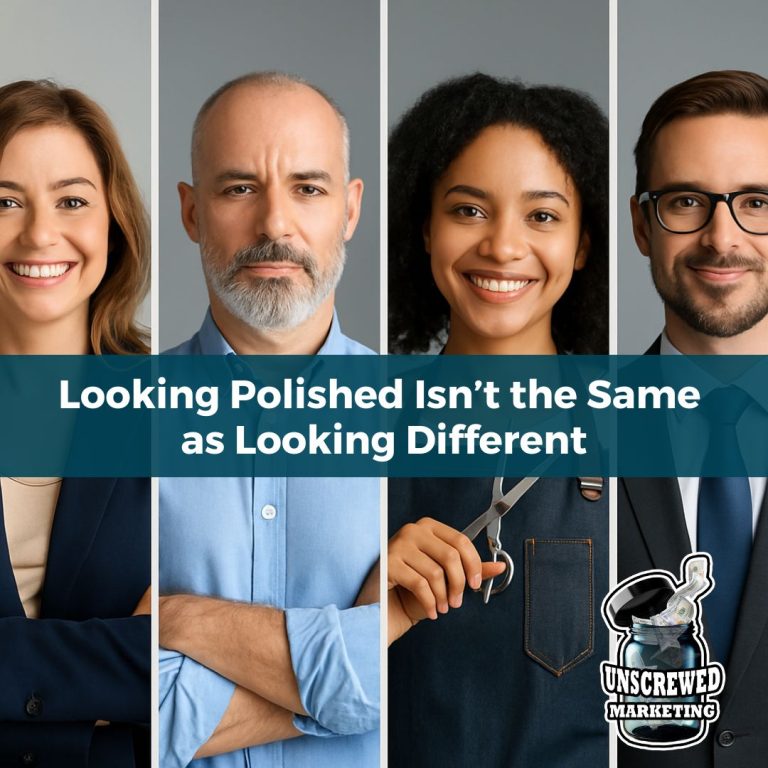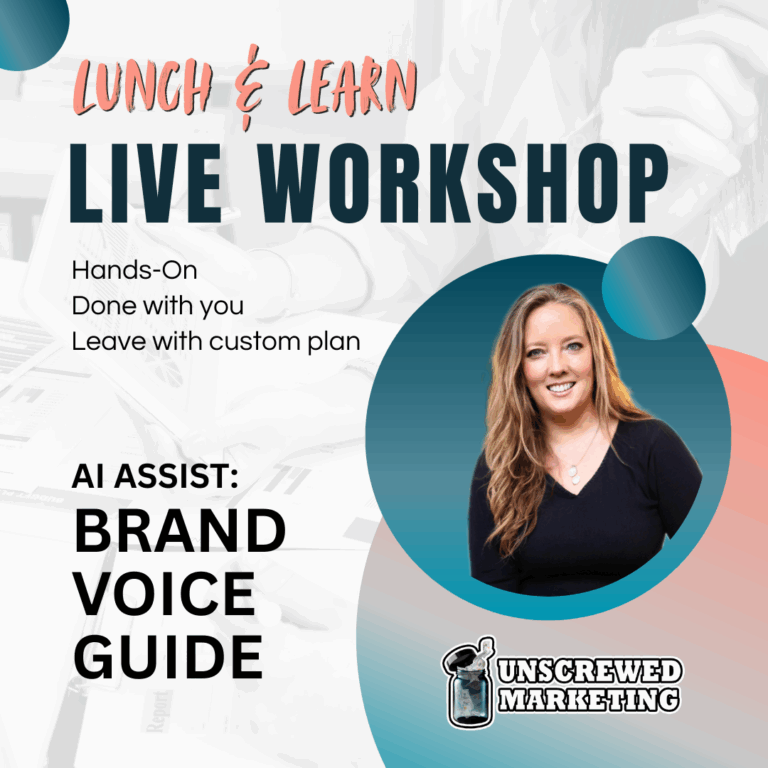- +1 512-591-8295
- [email protected]
- Mon - Fri: 9:00 - 16:00
- +1 512-591-8295
- [email protected]
- Mon - Fri: 9:00 - 16:00
Use code MOM50 at checkout thru Mother’s Day to get 50% off any gift card for marketing services

If your photographer told you to cross your arms, tilt your chin, and give a nice professional smile, congrats, you now look like 10,000 other professionals I’ve worked with over the years.
Literally.
When I was CMO for a major real estate brokerage with over a thousand independent agents (not to mention nine companies under the corporate umbrella and all of their staff), I saw the same thing again and again: safe, standard headshots. Some arms crossed. Some hands on hips. Some in model homes. And while these poses felt different on the surface, they all blended together. No one stood out. No one looked different.
In corporate worlds, this can be a chosen strategy, in the hopes that everyone looks alike, looks like the business. Makes sense.
I’ve seen the same thing in other industries, and the only way I can tell most people apart is based upon what’s in the background … a house? a dental office? new vehicles? hairdressing station? cleaning supplies? boardroom? If the background is doing all the work to differentiate you, then you’ve missed the point, because the focus of your headshot should be you as an entrepreneur.
I see it now with service entrepreneurs across industries—real estate agents, cleaning companies, financial advisors, beauticians, artists. Even when they’ve upgraded from the old head-and-shoulders crop (which is still necessary in many cases, even I have these on my website) to action-style images in context, they’re still missing the mark.
Because most of these photos aren’t communicating anything beyond, “I do the job I say I do.” That’s not branding. That’s just documentation.
This is similar to what I’ve told clients for whom I have written a resume (because that’s simply a personal marketing piece): your resume should not look like a career obituary (I did X). It should look like a highlight reel (I made $XYZ happen). And along a similar vein, your headshot probably shouldn’t look like you’re getting ready to do something I may not like.
Let’s call it what it is: cruise ship photographer syndrome. (And I do love cruise ships, and we always have our photos taken, and I always purchase at least one pose!)
The lighting is perfect. The smile is polished. The poses are flattering. But the result? You look like everyone else. Because the pose may change, but the message doesn’t.
And sometimes it’s even worse.
You look like you’re about to write a parking ticket. Or maybe sell me an extended warranty. Or file a zoning complaint with the HOA. Because when everyone’s crossing their arms and angling slightly forward, the energy shifts from “trustworthy professional” to “smug interchangeable authority.” Unfortunately
So no matter how much you’ve invested in “professional photos,” if they don’t show how you’re different, you may still be blending in.
And in this economy, that’s a risk you can’t afford.
You might think you’ve already solved this. After all, your photographer didn’t just crop your head and call it done. You’ve got the full-body shot in the kitchen. The cleaning company team standing with supplies in hand. The beauty pro who is mid-style with a client. The artist next to their canvas.
I love action shots. Definite step up from the super-posed head and shoulder basic.
And yes, those shots often do look great. Your photographer likely helped you with flattering poses, good lighting, proper framing—everything that makes you look polished and professional. Gotta love that. Even better if you went to a stylist to help select an outfit, a hair stylist, and a makeup artist as part of your shoot … and yes, even for the guys.
But here’s the thing: that’s still surface-level.
Because those photos may tell people what you do… but they don’t show how you’re different or why you’re the right choice for your ideal client.
That’s not the photographer’s fault. It’s not your fault either. The problem is that 99.9% of entrepreneurs have never gone deep enough into their branding (business branding, personal branding, or both) to know what makes them different in the first place, so how could a photo ever hope to capture it?
Here’s the hard truth: most entrepreneurs—and I mean nearly all I’ve encountered in over 30 years—have never gone far enough into their branding to even know what their visuals should be saying.
The majority have dipped a toe into the kiddie pool of branding. Some maybe made a logo, even professionally designed! Some picked a color palette. For the majority of entrepreneurs, they assume—or have heard—that’s what branding is. Some did a quick photoshoot.
A small percentage have gone deeper and realize that while those basic visuals: a logo and colors, go a long way into making a brand’s visual recall, it’s actually the communication, tone, voice, and words that generate the biggest differentiation. About 150 entrepreneurs, and growing, have taken my AI-Assist Brand Voice & Communication Guide Workshop (the live version, and now available as a self-paced course). It’s a solid first step, and they walk away with a usable brand voice guide that they can hand off to any designer, writer, or social media manager, or even the photographer taking their headshots.
But even those entrepreneurs—who are now miles ahead of their peers—still haven’t gone as deep as what fully helps, which is why we have two complementary workshops:
Let me be clear: I didn’t create these additions because I realized the first one wasn’t enough. I always knew all three branding pillars—voice, differentiation, and audience—were necessary. That’s something that I have hard proof of over the years of my expertise and tens of thousands of businesses that I’ve helped improve. But I also knew most entrepreneurs don’t have the capacity to do all of that level of work at once; it can be mentally draining to try in one sitting. The workshops are broken into pieces because the work is intense, and it needs space.
They’re built to go deep but without overwhelming you to the point of paralysis. That’s what good marketing or branding strategy should do: respect your time and meet you where you are, while still guiding you further than you could go alone.
Let me give you a real-world example—my own (even as it’s still being tweaked!)
When I first launched my company, I used my name. That was intentional. I had spent years building a strong reputation in the DFW business market, and using my name created instant recognition and trust.
But I always knew that was temporary.
I knew I’d eventually rename the company when I was ready for the next phase of growth. I didn’t know exactly what the new name would be—but that’s part of doing branding right. You don’t pick the name first if you can help it. You go through the process first. The name comes after the clarity. But either way, the deeper points of branding still work.
Then COVID hit. The pandemic shut everything down. Not a great time for a major rebrand. You never want major overhauls during questionable economies.
So I waited. Until I felt the timing was right.
Then I went through my full branding process on myself—just like I do for my one-on-one clients. Deeper than the workshops. Way deeper than most entrepreneurs ever go. I created my own Brand Voice Guide, my Differentiation Chart, my Audience Mapping Guide—all of it.
That’s how Unscrewed Marketing was born.
Not from a clever name list. Not from a moment of inspiration. From a rigorous, structured process that reflected exactly what I offer, who I help, and how I’m different.
And when I looked at my own prior headshots afterward?
They didn’t fit anymore. They don’t. (I haven’t updated those yet, but I do have a few that can still work.)
I was recently interviewed by Authority Magazine, and they asked for up to four headshots. One, of course, had to be the standard head-and-shoulders image. That’s a given in media submissions and for thousands of other purposes.
But the other three? That’s where differentiation can (and should) matter.
I haven’t even updated my professional headshots since my rebrand (something I still need to do), but because I had a clear brand guide, I knew what I was looking for. I dug through my image library and found some higher-res casual shots that matched my energy, voice, and approach, even if they weren’t quite studio-quality.
And that’s the point: knowing your brand helps you make better decisions, even with imperfect materials.
One of things about brand communication that is important is authenticity, which should be no surprise to you. I speak about that a lot related to videos … it’s more important to be authentic than polished. So authenticity in your headshots can be just as important, even if they aren’t professional quality.
These tips apply across the board:
And yes, I plan on taking my own advice when I get my new shoot scheduled.
Photographers are experts at lighting, posing, angles, and making you look good. But unless they know your brand strategy, they’re just guessing at the message you’re trying to convey (especially if you’re just guessing, too).
And many photographers—especially those who work with service professionals—default to the poses they’ve always used. It’s not unlike that cruise ship photography. You’ll look good… but you won’t look distinctive.
That’s why I tell my clients: take your brand voice guide and your differentiation chart to your shoot. That one we created in the workshop I mentioned, or for some clients the one I’ve directly created for them.
Sit down with your photographer. Let them see the important pieces from your guides. Talk about how you want your brand to feel. Is it rebellious? Welcoming? Analytical? Bold? Structured? Playful? Black? Pink? Earthy?
Then—and only then—can they help craft visuals that actually communicate those messages. They’ll be able to give you even better work because they know what you need.
What I see after each of the three workshops—Brand Voice & Communication, Differentiation & Niche, and Audience Strategy—is a shift. Entrepreneurs start to see what they couldn’t before.
Not because they didn’t care. Not because they weren’t trying. But because they’d never been given the tools to truly understand their own brand.
After the Brand Voice workshop, they start thinking:
After Differentiation, the message becomes clear:
After Audience?
It’s not uncommon for clients to come out of this process with the realization that their current visuals, site, or copy don’t match who they’ve become—and that their old materials were only “working” on the surface.
Some people are in roles where they can’t change everything, such as if you’re part of a franchise. That’s okay. You can still work with the constraints and build something sharper, more aligned, and more you.
This isn’t about being edgy or weird or provocative. It’s about being true and making that truth visible. Because a picture is worth a thousand words… but those words need to say the right thing.
If your visuals don’t convey who you are, what you stand for, and why you’re different? They’re wasting space. And potentially costing you clients.
Let’s fix that.
Before you book new headshots (especially if you haven’t done branding work yet), try this simple test:
If your answers made you cringe a little? You’re not alone. That’s the exact gap my branding workshops are built to close. While they aren’t about photos, they will help you properly address these gaps.
Start where it counts—with the AI-Assist Brand Voice & Communication Guide Workshop.
We’ll build the clarity that makes every decision—from photos to websites to copy—feel easier and smarter.
Already nailed your voice? Let’s dig into what actually makes you different.
The AI-Assist Differentiation & Niche Workshop goes beyond “ideal client” fluff and gets to the core of how you stand out in saturated markets. This works better when you’ve already done the work on your voice and communication.
Got those two tuned in?
The AI-Assist: Audience Definition & Attraction Workshop (coming soon) goes far beyond basic demographics; we dig into the psychology, emotions, and primal motivators of your audience in ways you’ve likely never explored, then turn those insights into messaging that makes your prospects feel deeply seen and compelled to choose you.
And if you want real support? The entrepreneurs who get the most out of this work join all three. Or they choose me to work with one-on-one for a full branding package that covers all three and more. Because your voice, your difference, and your audience are the foundation of everything.
Brand Strategist • Fractional CMO • Artist Who Still Cringes at Bad Logos
Before I ever touch colors or logos, I help entrepreneurs uncover what their brand actually needs to say. With over 30 years in marketing and a background in fine art and commercial design, I guide clients through the kind of brand clarity that turns confusion into confidence—and yes, sometimes that starts before you even have a name.
I’ve helped nonprofits, startups, and multi-billion-dollar companies rebrand from the inside out. My process blends psychology, emotion, and positioning strategy so that everything from your messaging to your visual identity finally clicks. I’ve even had logos for large corporations in use for 25+ years—but my real joy is watching entrepreneurs light up when their brand finally feels right.
Because branding isn’t just about how it looks. It’s about how it works.

Vicky Wu, CEO
Author

This website uses cookies to ensure you get the best experience on our website. By continuing to use the website, you agree to our use of cookies. We do not share or sell your information. More info